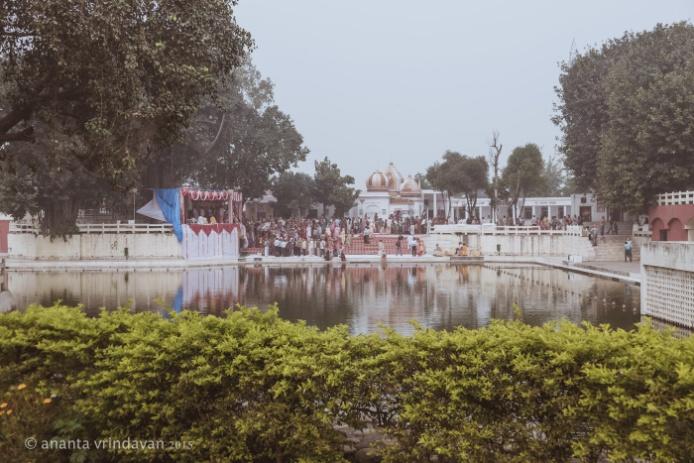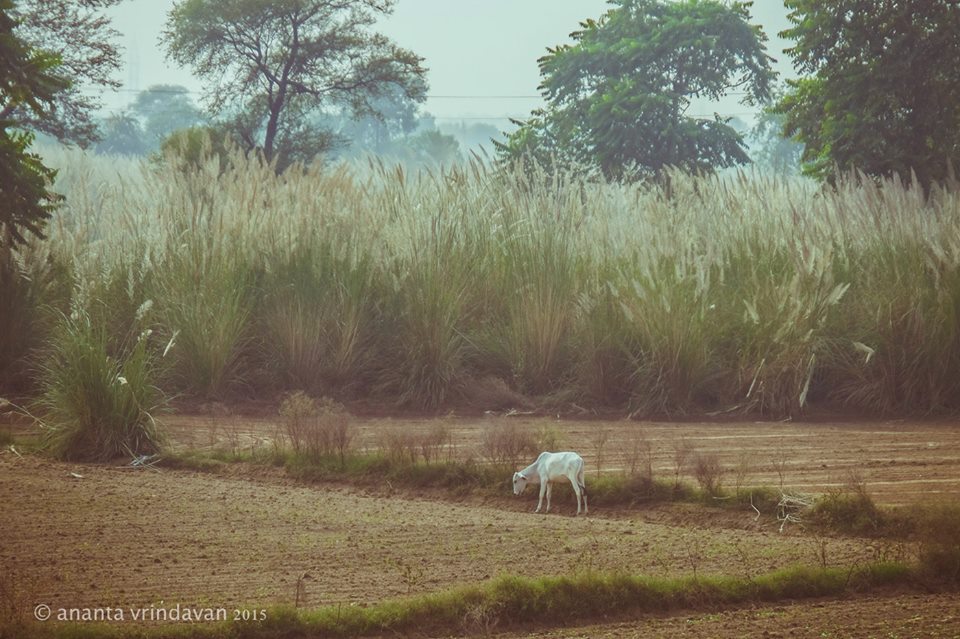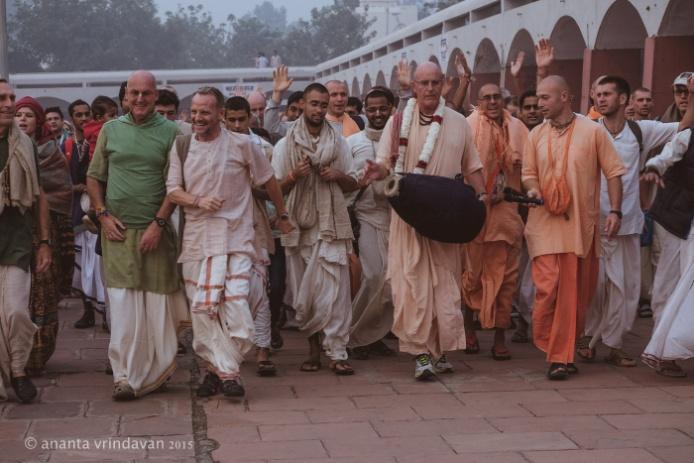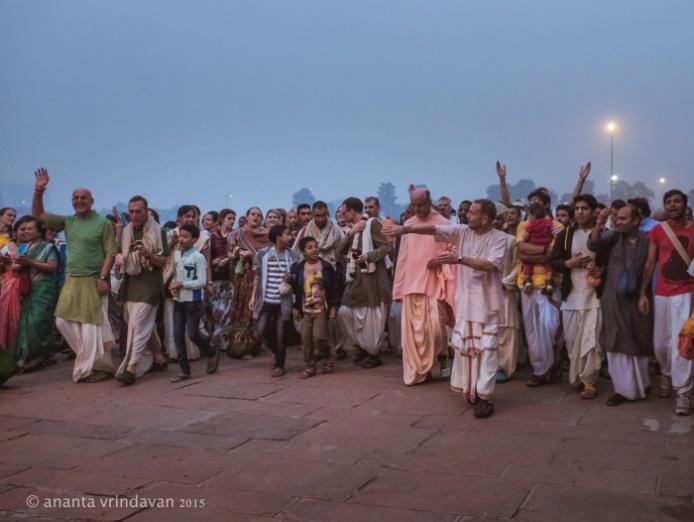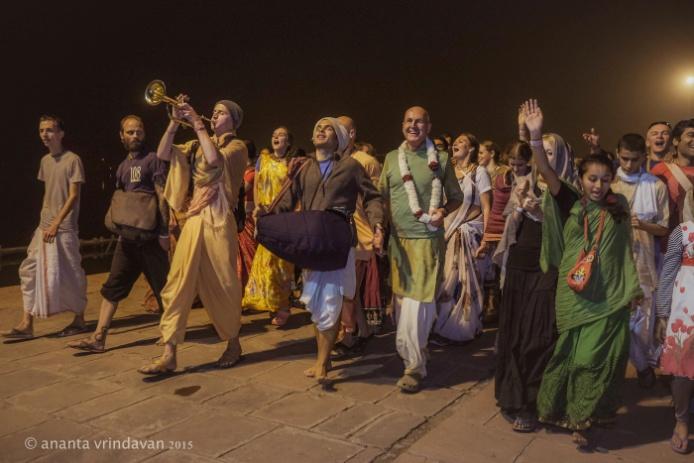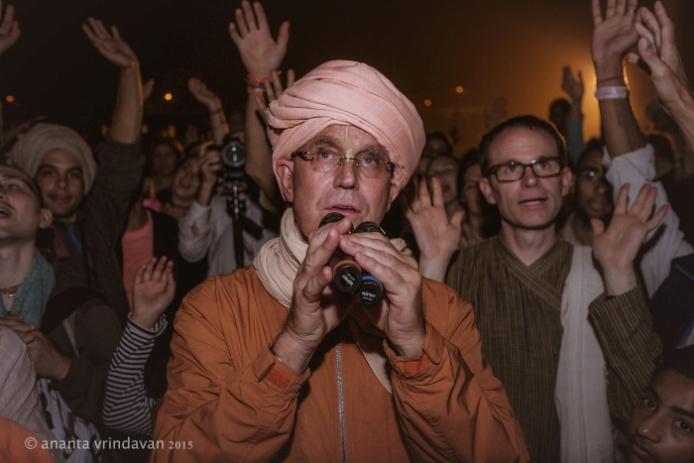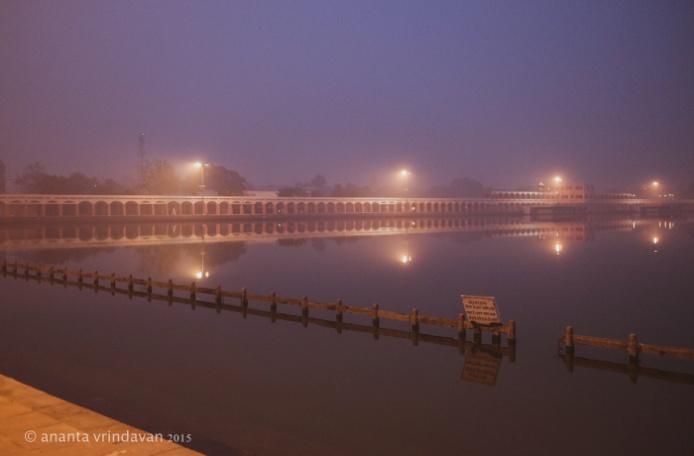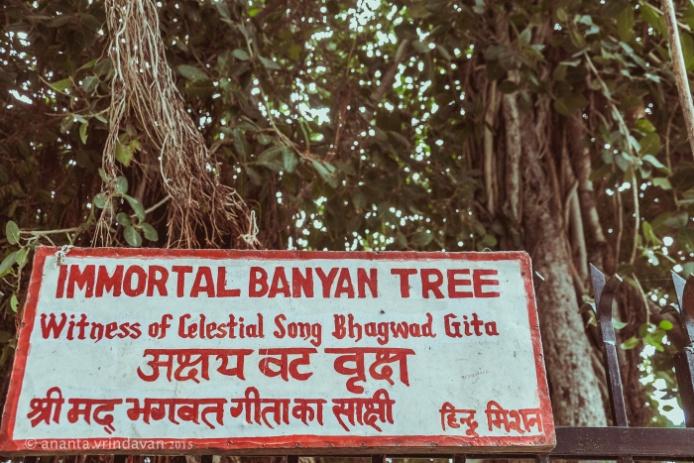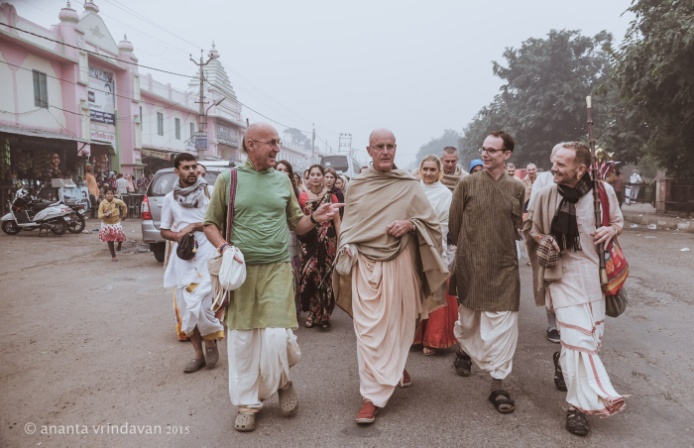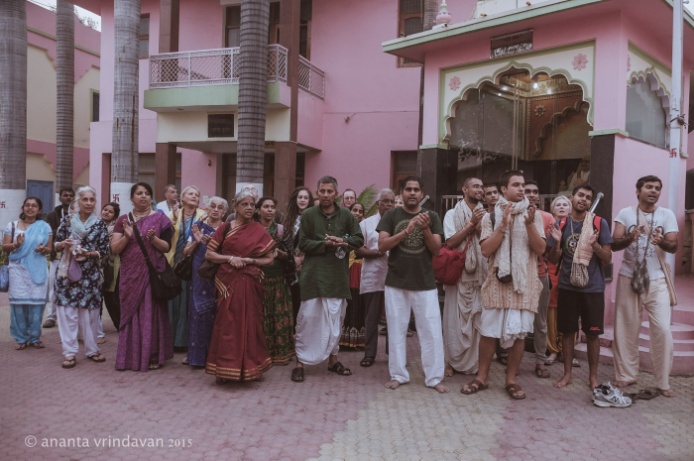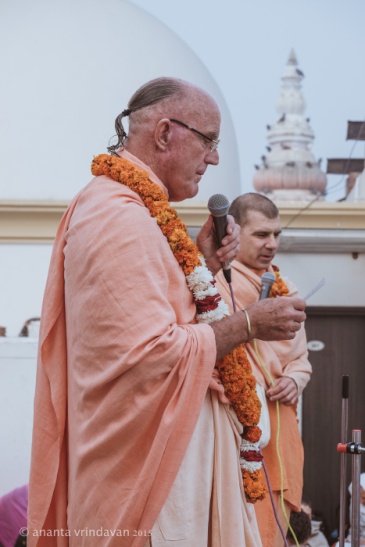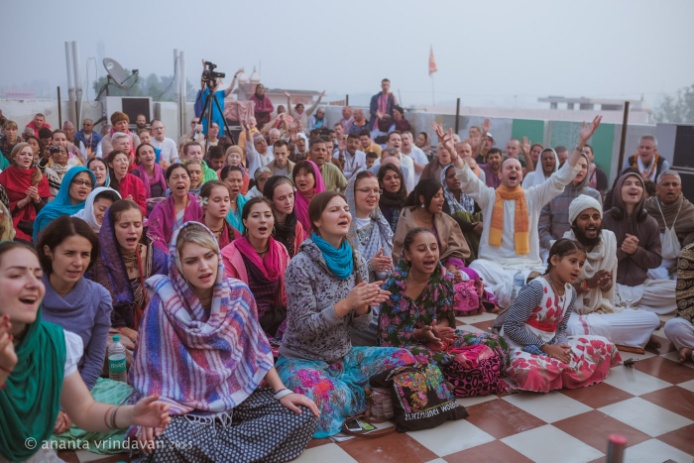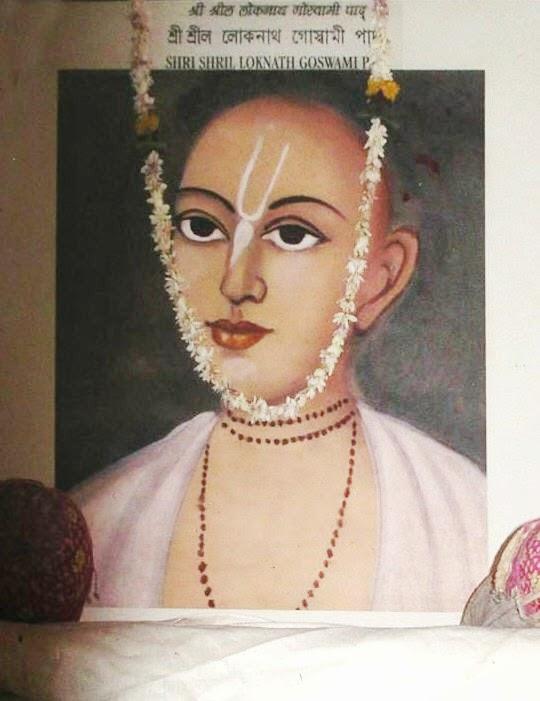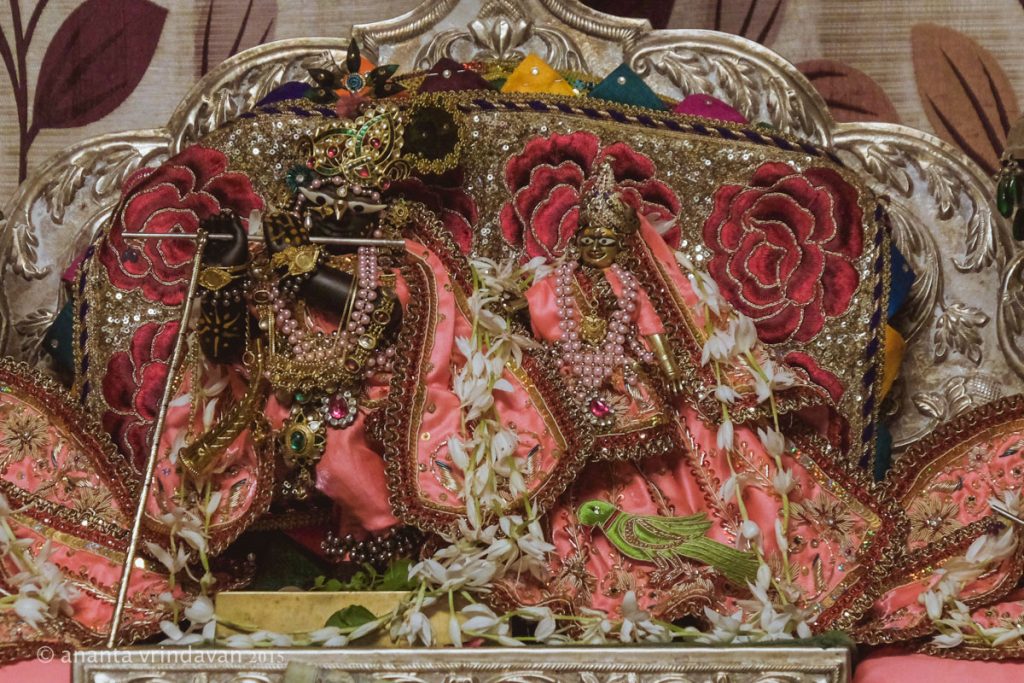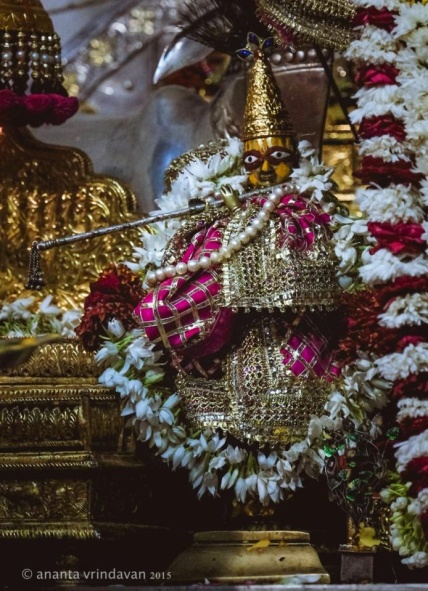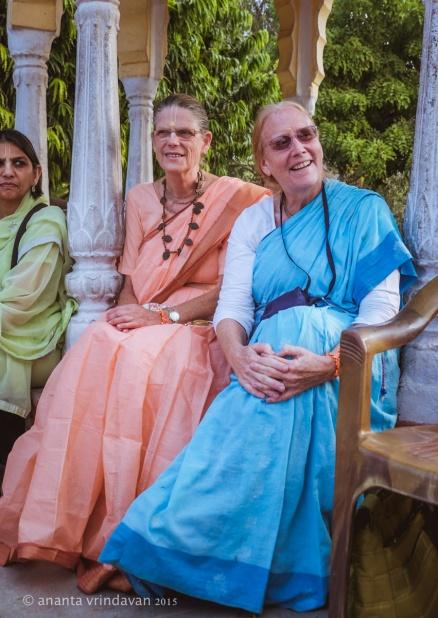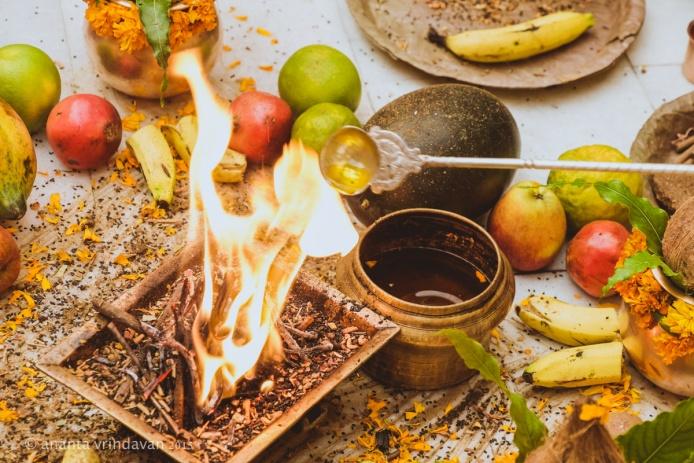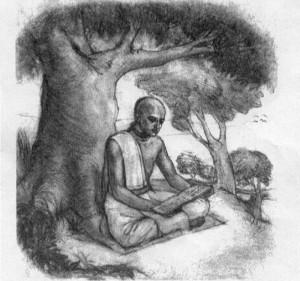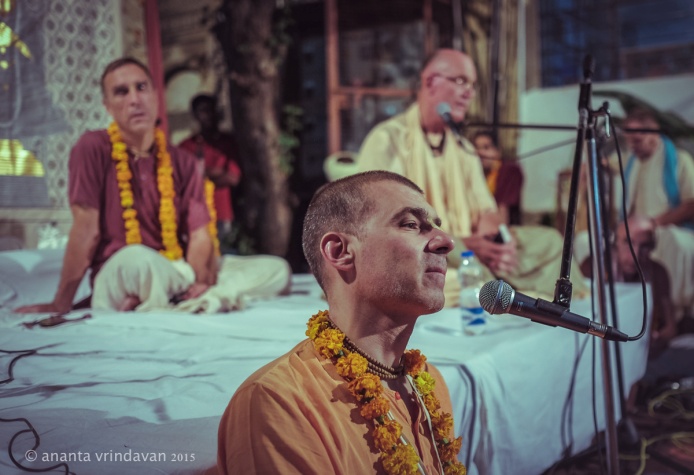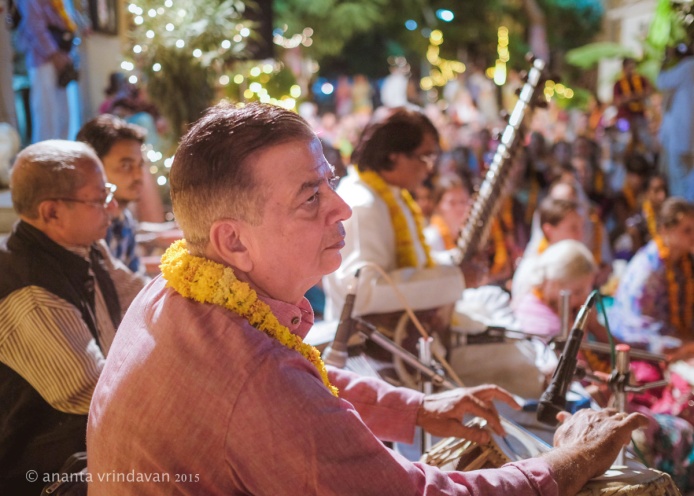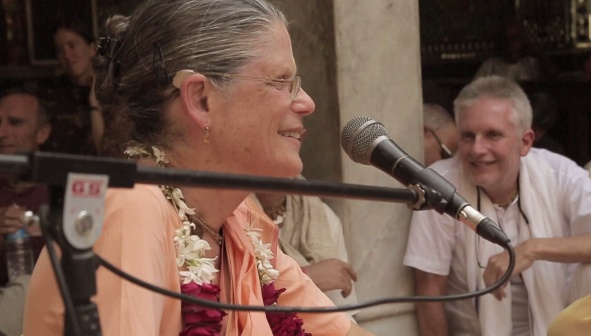– By His Holiness Śrīla Indradyumna Swami
[Following opening address follows from 59:28 time laps in above video after Madhav Prabhu’s Kirtan]:
Prabhus, I’d like to welcome all of you to Nityānanda–vat. It’s also called Śrīngāra–vat. We’ll be discussing this during our talk this morning. But before we begin, it’s my very great pleasure to introduce you to one of my spiritual mentors and a very, very, very, very, very close friend of mine who is a direct descendant of Lord Nityānanda—Anup Gosvāmī. [Applause, “Haribol!”]
I met Anup Gosvāmī a couple of years ago in a very unusual way. He’s the Mahānta in charge with his family, but he takes most of the responsibility for this sacred place. That is a very prestigious position, but he showed his very deep humility. One day, I was doing Parikramā and I was just outside the road here and it was kind of a rainy day, and there was this Bābā, this Sādhu with long white hair and disheveled blue clothing out there begging for a few rupees for his Nitāī.

I kind of bumped into him and he said, “Oh Mahārāja, can you give a few rupees for Nitāī?” I thought, “Who is this Bābā?” I didn’t have much time and I kind of, I don’t know if I gave a small donation, went on my way, but later on, I learned and realized that he’s actually the Mahānta, he’s in charge of this great project here.
I came back to offer my respects and a very close relationship began over time. Actually a couple years ago, I brought Anup Gosvāmī to Poland and he was on the Polish Festival tour for about two or three weeks. I was a little hesitant to take him to Woodstock, because if any of you have been to Woodstock, it’s really the epitome of Kali Yuga. There are so many Jagāis and Mādhāis—real Jagāi—modern-day Jagāi and Mādhāis, and I thought Mahārāja is from India, he’s a Gosvāmī, aristocratic family, he might be kind of repulsed by seeing all these low-class people drinking and wearing very few clothes and speaking bad language. I thought “Oh, this may not be good for Gosvāmī.”
But I remember the first Kīrtana we had in the Kīrtana yoga tent that night. We have that tent, we have Kīrtana with all the kids who come—there must have been a thousand kids in the tent. And I think it was Mādhava Prabhu who was leading and all these youth, these kids from all over Poland, many of them were drunk. They were chanting, “Hare Kṛṣṇa! Hare Kṛṣṇa!” And Mahārāja was in ecstasy; he was like, “Jaya Nitāī! Jaya Nitāī!” And he just got so ecstatic and I thought, “Wow! This is the mood of Lord Nityānanda who displayed the ultimate compassion to the most fallen souls.” He was the Commander-in-Chief of Lord Caitanya’s Saṅkīrtan Army.
He’d come to Kīrtana every night and just sit there and relish seeing all these fallen souls chanting Hare Kṛṣṇa. And I thought that was enough. He should just stay back in the school during the day, because we’re going out on the Ratha Yātrā. We’re passing all these kids passed out on the ground, sleeping in their tents, drunk. He said, “No, no, I want to go on Ratha Yātrā.” And during the parade he was right out front with this symbol that Nitāī used to carry for the Saṅkīrtan party and he would be chanting and dancing, “Chant Hare Kṛṣṇa! Chant!”
He is a great well-wisher, he is very appreciative of Śrīla Prabhupāda’s efforts to take the mercy of Gaur–Nitāī to the western countries, and he’s very supportive of our International Society for Kṛṣṇa Consciousness. So I’m always trying to tell him, “I am your servant—”Daso ‘smi, Daso ‘smi”—He said, “No, we are friends.” But the reality is I am his servant. He’s very kind to see me as a friend, because we love doing the same activity, spreading the mercy of Lord Nityānanda all over the world, to all the Jagāi and Mādhāis of Kali Yuga.
He has practically single-handedly carried on the project here. He has a very wonderful devotee wife; she cooks very nice Prasādam. But practically single-handedly he’s maintaining this whole place, he maintains these beautiful Deities, preaching the glories of Nityānanda, so it’s quite touching to the heart. And he loves when we come here and have our programs. He would be happy if we came here every day.
I love to come here. Yesterday, I was very sick. I was crying in pain. And usually when I get that flu you get here in Vṛndāvan, it usually lasts three days. I was praying last night, “Please, Kṛṣṇa, please cure me so that I can go to the program and serve the lotus feet of Anup Gosvāmī”—and I got better. I’m fine.” [Applause, “Haribol!”].
He’s the care-taker of some very precious objects—transcendental paraphernalia. He actually has the jewels that Nitāī would wear around his arms when he would go out on Saṅkīrtan. He has those in his room—you can go and take Darśana later in the morning. Those jewels were brought by Mother Jāhnavā here to Vṛndāvan for safe-keeping, Jāhnavā Mata. He is the caretaker and the fierce protector of these beads. These are the beads of Śrīla Jīva Gosvāmī. And after the program is over, he’ll take the beads back in his room and you can come and have Darśana of these beads, and you can offer some nice donation for the Sevā of this sacred place, Nityānanda vat.

We have a very friendly relationship, but sometimes Gosvāmī chastises me very heavily. “Mahārāja, why aren’t you coming down to Nityānanda-vat? And simply sitting here chanting on the beads of Jīva Gosvāmī? Why aren’t you coming daily and chanting on the beads of Jīva Gosvāmī?” That’s a very nice chastisement. Such an offering is simply causeless mercy we can hardly comprehend, how much mercy that is. So I asked him in his room very humbly if I could wear the beads of Jīva Gosvāmī during my discourse, so I might get some intelligence and say something nice. I think he agreed. [Applause, “Haribol!”].
[Anup Gosvāmī speaking]:
nitāiyer koruṇā habe, braje rādhā-kṛṣṇa pābe
dharo nitāi-caraṇa du’khāni
heno nitāi bine bhāi, rādhā-kṛṣṇa pāite nāi
dṛḍha kori’ dharo nitāir pāy
āra kabe nitāi-cānder koruṇā koribe
saṁsāra-bāsanā mora kabe tuccha ha’be
viṣaya chāriyā kabe śuddha ha ’be mana
kabe hāma herabo śrī-bṛndābana
rūpa-raghunātha-pade hoibe ākuti
kabe hāma bujhabo se jugala-pīriti

[Anup Gosvāmī speaking…Translation follows]
“One who wants the mercy of Lord Nityānanda, they must come here. Nityānanda Prabhu has four places: one is His place of birth, one is His place of marriage, one is Kharda, and one is here. When Nityānanda Prabhu first came to Vṛndāvan, this is where He met Mahāprabhu. From here He went to Navadvīpa. And then from there, He went to Nandanācārya’s place where He met Mahāprabhu. Then Jāhnavā Ma came to Vṛndāvan with this Kunti. That Kunti was given to Nitāī by Hussain Shah. That Kunti here is being worshipped here. Here there are three small Murtis: Nitāī–Gaura and Jāhnavā Ma. Those Deities were brought here from Bengal by Vīracandra Prabhu.”
“And then the disciplic succession was maintained here. Since then the worship has been done and the Kunti has also been worshipped here. Until then, since that time, only the descendants of Nitāī have been worshipping here, Jīva Gosvāmī, who is a conduit of Nitāī’s mercy. Before, my father was in charge of the Rādhā–Dāmodara temple. At that time (1962), Śrīla Prabhupāda was in Vṛndāvan. My father was the one who gave Śrīla Prabhupāda the place to stay in Rādhā–Dāmodara. So when they gave the temple over to the next authorities who are taking care of it now, at that time, they took the beads with them. Since that time, the beads have been worshipped here.” “Jaya Nitāī! Nitāī-Gaur Haribol!” [Applause].
[Śrīla Indradyumna Swami Mahārāja speaking]: I’d like to remind all the devotees to please give very generously to Anup Gosvāmī. You will be greatly benefited by donating to a direct descendant of Lord Nityānanda. If you want Nityānanda’s kṛpā, Nityānanda’s mercy, then you help this Sādhu, this Gosvāmī maintain this most sacred place.
I myself give lots of lakṣmī to this temple, because it’s a very, very special place and he’s a very special devotee. We’ll also be bringing him back to Poland again this year for part of the summer tour. And this year, we are going to bring his good wife, as well. She can give counsel and instruction to all the young ladies.
So you can either give to Mahārāja directly or when you go into the room to see the jewels of Lord Nityānanda which you know you can’t see in one billion lifetimes, you can give a nice generous donation to Mahārāja there. Okay, so I’ll be speaking now about Śrīngāra-vat and Nityānanda–vat.
I’d also like to take the opportunity to welcome a very dear friend of mine and a very wonderful disciple of Śrīla Prabhupāda, His Holiness Kavicandra Mahārāja, he’s joining us today. [Applause, “Haribol!”] Mahārāja is a member of the GBC, sannyāsī, initiating Guru, and has so many responsibilities all over the world. So this place is auspicious, but his presence makes it even more auspicious.
Kavicandra Gosvāmī Maharaja ki—Jaya!
Śrīla Prabhupāda ki-Jaya!
Śrī Nityānanda-vat ki—Jaya!
Śrīngāra-vat ki—Jaya!
Gaur Premanande! – [“Haribol!”]
[Opening prayers…]
Five thousand years ago, even in more recent history, five hundred years ago, the Yamunā river used to flow right by here. That’s why you see all these sitting places, all little shrines as you walk along the area here, because they were all built on the banks of the Yamunā river. Now Yamunā Mai has shifted some couple hundred yards, or a mile in the distance, but traditionally this was where the Yamunā river flowed by. And at that time, Vṛndāvan was actually a van—it was a forest of trees. Now it’s become a concrete jungle.
Five thousand years ago, this was a place where all the cowherd boys would come and their cows would drink the fresh water of the Yamunā and eat the soft grasses on the banks of the Yamunā. And simultaneously, this was one place where Rādhā and Kṛṣṇa would come and have Their confidential pastimes. Actually, most pastimes take place in particular places. The Rasas are not mixed, so the cowherd boys don’t mix with the girls and the parents don’t mix with the kids. The Rasas take place in different parts of Vṛndāvan. They don’t mix. But this is one place where both the cowherd boys would come and the Gopīs would come. It’s a very unique place. Previously, this particular place where you’re sitting was distinguished by the fact that there was a huge banyan tree here of which you see a small portion there still remaining. So in Sanskrit, the Banyan tree is called vata. Vata means many things, but it also means “Banyan tree.” And Śṛīngāra means decorating with clothes and jewels and ornaments.
Śṛīngāra–vat means that place where Kṛṣṇa often decorated his beloved Śrīmatī Rādhārāṇī with clothes and ornaments and jewels and make-up and so forth—here. And as the cowherd boys would see from distance or hear about Kṛṣṇa decorating Rādhārāṇī, they became inspired by the Gopīs‘ service and they asked Kṛṣṇa and Balarāma if they could also dress them in beautiful clothes and ornaments here at Śṛīngāra–vat. So Viśvanāth Cakravārtī Ṭhākur says, Devotees come here to be inspired in that same type of service, particularly dressing Kṛṣṇa in beautiful clothes and ornaments. In his prayers to the spiritual master, Viśvanāth Cakravārtī Ṭhākur sings, “Śrī–vigrahā rādhana–nitya–nānā–śṛṅgāra”—that one of the duties of the Spiritual Master is to engage and train his disciples in decorating the Lord in a particular form as His, in the Archa-Vigraha, the mercy incarnation of Kṛṣṇa.
This is the place where pujaris come to be inspired in that service of dressing Kṛṣṇa in beautiful clothes and ornaments, putting jewels and decorating in this way. They come here to become inspired to perfect that particular service. Śṛīngāra–vat: very important place.

By Kṛṣṇa’s arrangement I was listening to a tape just the other day and Prabhupāda was saying, “One should worship Kṛṣṇa not just once a week or just once a month, but one should worship Kṛṣṇa twenty-four hours a day.” He said, “In this regard, we have our worship to our beloved Deities.” Then he paused and you could tell he was addressing whoever the pujaris were and he said, “Kṛṣṇa should have a nice dress, not once, not twice, four times a day—or as much as possible!”
He said, “Kṛṣṇa is the most opulent Enjoyer. And the duty of His devotees is to supply Him things with which He can enjoy.” So here the whole business is decorating Kṛṣṇa with beautiful clothes and ornaments. And Kṛṣṇa, He set the example Himself, here at Śṛīngāra–vat. Because it is here, right under this Banyan tree that Kṛṣṇa would sometimes dress and ornament Śrīmatī Rādhārāṇī in preparation for the Rāsa dance. It’s interesting because generally we think of the manjaris or the sakhis as those personalities who decorate beautiful Śrīmatī Rādhārāṇī. Rūpa Gosvāmī says generally, the Gopīs generally decorate Rādhārāṇī eight times a day. But sometimes Kṛṣṇa had the opportunity to help them in that service. And when He did so, He did it so expertly, with so much love, that all the cowherd girls would eagerly watch His every move in decorating Rādhārāṇī in order to improve their own service to Her. So the Ācāryas describe one of those particular pastimes.
Here on the bank of the Yamunā in this forest of trees with this big Banyan tree, Rādhā and Kṛṣṇa met here and for a long time in the Kunja, Kunja-bihari—Kṛṣṇa’s the Enjoyer of the groves of Vṛndāvan—They performed Their confidential pastimes. And in the midst of those pastimes, They lost track of time. We often say some kind of material śloka that, “If you’re doing something you like, time passes very quickly, and if you’re doing something you don’t like, time passes very slowly.”
In the midst of Their topmost confidential pastimes, They lost track of time, so Vṛndā–Devī, who’s in charge of arranging all these pastimes, she arrived and she said, “Hey, You’re both going to be late for the Rāsa dance this afternoon.” So at that moment, that time, Rādhārāṇī manifested some māna—it means She became angry with Kṛṣṇa. Kṛṣṇa: “We’ve just enjoyed Our transcendental pastimes, why are You angry at Me?” So Rādhārāṇī said, “You lost track of time. We’re going to be late for the Rāsa dance. And all My Gopī friends will miss out on Your transcendental association.” This is the compassionate nature of Śrīmatī Rādhārāṇī, Prabhupāda describes in the Caitanya–Caritāmṛta that She’s such a great devotee, She takes ten thousand times more pleasure to engage others in Kṛṣṇa’s service than Herself doing the service.
Then She said, “And look at Me!” She was all unkempt and disheveled, because of Their pastimes, Her dress was here and Her hair was here. She said, “How am I going to show up at the Rāsa dance like this?” So Kṛṣṇa reassured Her, He said, “Devī, let Me put You back together very nicely. Let Me put on Your make-up. Let Me decorate You with all these gold and diamond and rubies and sapphire ornaments. And I promise You it won’t take more than a minute.” So Rādhārāṇī turns to Lalitā and Lalitā says, you know, “He’s just a boy, He’s a cowherd boy, we can do better than Him.”
Rādhārāṇī tended to agree with her, but in Her heart of hearts, She wanted to have that intimate association with Kṛṣṇa, so after awhile, She said, “Alright, but do it nicely and don’t do it too quickly. Don’t rush the job.” So Kṛṣṇa looked around, He was smiling. So you can see the remnants of this Banyan tree, this big beautiful tree, right there where devotees are sitting, Kṛṣṇa sat with Rādhārāṇī to put on Her makeup and Her jewels. And He asked the different Gopīs to go different places and acquire different jewels and ornaments and bracelets and bangles and make-up, so all the Gopīs ran off and got all this paraphernalia and came back.
Viśvanāth says that as devotees, each of us have a worshipable Deity whom we love to serve in so many ways. And Kṛṣṇa, although He’s God, He also has His worshipable Deity who He loves to serve: Śrīmatī Rādhārāṇī. Viśvanāth says dressing Her is the life of His life. So understandably Kṛṣṇa took a long time. And when He finished He stepped back, and all the Gopīs went, “Oh, soooo beautiful dressing you’ve done. You’re a boy, but you have done such beautiful dressing.” So Viśākhā whispered something in the ear of Lalitā, so Lalitā who’s usually very kind of fiery and she gets angry when Kṛṣṇa mistreats, so-called mistreats Rādhārāṇī, she stood up at a very unique time, she said, “On this very day, under this banyan tree at Śṛīngāra–vat, we declare that this cowherd boy, Kṛṣṇa, He’s the emperor of pujaris.”
Then everyone just looked at the beauty of Rādhārāṇī, Her transcendental beauty, Her effulgence, all Her divine qualities and how expertly Kṛṣṇa had decorated Her with the jewels and ornaments. Everyone, just like, they became like statues, nobody was moving, just totally immersed in observing the beauty of Śrīmatī Rādhārāṇī as Her beloved Kṛṣṇa had dressed Her; only Rādhārāṇī had not said anything. The Sakhis had all shown their approval and all the young manjaris, they were just stunned but Rādhārāṇī hadn’t said anything yet.
Tunga–Vidyā, one of the sakhis, very carefully came forward and offered Rādhārāṇī a mirror. And as everyone was looking, Rādhārāṇī took that mirror and She looked at Herself, that reflection, and She smiled. Everyone’s heart became pacified. But then She said, “Oh! We’re late! Let’s go for Rāsa!” And they went over to a place called Nikuñja–vana, where the other Gopīs were waiting impatiently for the Rāsa dance. And you know the Rāsa dance was going on, it’s a very wonderful occasion. It doesn’t just happen once, it happens all the time in different places around Vṛndāvan. On this particular occasion, all the Gopīs are whispering, “Rādhārāṇī looks especially beautiful today. Who dressed Her?”
The word got out that Kṛṣṇa dressed Her and all the Gopīs were smiling and their love and appreciation for the Emperor of Pujaris increased unlimitedly. So I mentioned the cowherd boys would bring their cows down here to drink the fresh clear water of the Yamunā river and to eat nice, soft green grass that grew on the banks of the Yamunā river. So the cows are grazing and they’re drinking the water and you know, boys are boys, and they’re just kind of laying down and throwing their sticks up in the air and kind of playing with each other and exchanging sweets, like that, and suddenly, Subala says, “Hey, boys! Why don’t we decorate Kṛṣṇa and Balarāma?”
Raktak, one of the boys, he said, “Decorate? Kṛṣṇa and Balarāma? What do you mean?” So Subala said, “You know, like, when we go through the villages and we see the brāhmaṇas, they’re in the temples, they’re decorating their Deities, let’s do the same thing. Let’s decorate Kṛṣṇa and Balarāma like the Brāhmaṇas decorate their Deities in the villages.” So [they are] laughing and saying, “Yeah!” You know, it’s not that they see Kṛṣṇa as God like a Deity who they’re going to [decorate], but they just want to imitate the Brāhmaṇas in the village who decorate Deities, so “Yeah, let’s decorate Kṛṣṇa and Balarāma. That’ll be a lot of fun!”
Viśvanāth says, in the same way as Rādhā and Kṛṣṇa are for the Gopīs their worshipable Deities, so Kṛṣṇa and Balarāma are ultimately, although the boys don’t acknowledge it, the worshipable Deities of the cowherd boys. All the cowherd boys approached Kṛṣṇa and Balarāma; “Oh!” Kṛṣṇa and Balarāma thought there was going to be a wrestling match. They’re tightening Their belts, “Okay, boys, we going to have a wrestling match?” And the boys said, “No, we’re going to decorate you with beautiful clothes and ornaments.”
Some of the boys found a big slab of marble that was hanging around and they put it right next to that banyan tree right where Kṛṣṇa decorated Rādhārāṇī and they put Kṛṣṇa and Balarāma on that marble slab. And you know Kṛṣṇa and Balarāma are kind of uncomfortable, saying “What’s going on, guys?” “We’re going to decorate you.” “Well, okay.”
One of the boys said, “Wait a minute! Let’s make a canopy!” Because we see in the temples when the Brāhmaṇas decorate the Deities they have kind of a sṛnga-asana over Them. The boys, “Oh yeah, yeah!” So they went and got twigs and flowers and leaves and vines and they made a beautiful canopy over the marble slab where Kṛṣṇa and Balarāma were sitting.
Subala said to Raktak, like, “Well, how do they do it? What do they do?” So Raktak said, “Well, you know. They open the doors and then they pour water on the Deities’ feet.” So some of the boys ran over to the Yamunā, got some water, and they sat, they started pouring the water over Kṛṣṇa and Balarāma’s feet. Then he said to Raktak, “What’s next?” He said, “They take soft cloth and they wipe down the Deities.” So the boys took soft cloths and they started down the legs and the feet. It was all kind of in fun, because in Vṛndāvan, there’s no aisvarya Bhāva, it’s all spontaneous fun. Kṛṣṇa’s your friend, He’s your child, He’s your lover. But they were pretending in the mood of the Brāhmaṇas in the temples. And everybody was having a good time.
Then Subala said, “Get some more things we can offer”, so the boys went around. They got flower garlands and different ornaments; they got colored minerals and different dust of Vṛndāvan. Some of them found some fresh silk cloth and they put it on trays and they all came forward and very reverentially offered all these articles to Kṛṣṇa and Balarāma. This is all happening right here, this is why this is Śṛīngāra-vat. So then Subala said to Śrīdāma, “Śrīdāma, you know, you’re really good, you’re like an artist, can you go paint some beautiful designs of fish and birds on the faces of Kṛṣṇa and Balarāma?”
Very soon the pastime was over and the boys said, “Let’s go play down at the Yamunā”, and it was sort of the kind of thing they did for a few hours and then later when Kṛṣṇa snuck away to meet Rādhārāṇī at twelve noon at Rādhā Kuṇḍa, He came with these beautiful designs on His face and silk cloth and His hair was combed and jewels and you know, Rādhārāṇī hadn’t seen Him like that before—ever really. They were all like, “Wow, look at Kṛṣṇa! He looks different today!”
The Gopīs are saying, “He is so wonderfully decorated.” And all the Gopīs were thinking, “Who dressed Kṛṣṇa so nicely?” This is Śṛīngāra-vat; this is where Kṛṣṇa would decorate Rādhārāṇī and this is where the cowherd boys would decorate Kṛṣṇa and Balarāma—very special place. Viśvanāth concludes by saying that Śṛīngāra-vat is a place where we can come and meditate on the expertise of Kṛṣṇa, the Gopas, and the Gopīs in dressing Their respective Deities and refine that devotional service ourselves.

How many of you have Deities? Worshipping Deities? Well, this is a very special occasion. Later you can put your head on the wood of this ancient banyan tree and pray to become expert in that service of worshipping your Deity. And to commemorate these wonderful pastimes at Śṛīngāra–vat, you can see over here on your left there’s a little altar where those pastimes are depicted. Now if you ask Anup Gosvāmī where we are, he’ll say, “Where are we? Nityānanda–vat!” “Anup Gosvāmī, where’s Śṛīngāra–vat?” “Yes, we’re at Nityānanda–vata!” Vata again means banyan tree, so Nityānanda–vata means that place where Nityānanda when He came to Vṛndāvan, this is the first place He came and He sat under that banyan tree.
Just up the Parikramā Mārga here a little way there’s a place called Imli-tala. When Lord Caitanya came to Vṛndāvan for the first time, He sat at Imli-tala and that’s commemorated with a beautiful temple and Deities, so when Nitāī came, He came to Nityānanda–vat. He sat under this banyan tree.
If you remember from your studies in Caitanya-Bhāgavata or Caitanya Caritāmṛta, there was a period where Nitāī went on pilgrimage all around India waiting for the Saṅkīrtan movement to start, because it took some time for Nimāi to grow up, take sannyāsa and start the Saṅkīrtan movement, so where did Nitāī wait? He waited here at Śṛīngāra–vat.
While here at Śṛīngāra–vat, Nitāī would play like a little cowherd boy here on the banks of the Yamunā, remembering His pastimes as Lord Balarāma. And when local children would come here to swim in the Yamunā, He would join them in their childish games. Now again, Nimāi was growing up and He was Nimāi Paṇḍita. He had His Gurukula, His school, He had His pastimes. So He took sannyāsa, I think at the age 25, so the Saṅkīrtan movement didn’t really begin in earnest till a little bit before that and after that, Nitāī didn’t join Lord Caitanya until the Saṅkīrtan movement actually started.
Nityānanda was sitting here anxiously waiting for the Saṅkīrtan movement to begin. Something like it’s a big marathon, the December marathon and you’ve finished Prasādam and you’re waiting for all the devotees to get in the van and go out, and you’re anxiously waiting to go out on Saṅkīrtan. So Nitāī was sitting here anxiously waiting for the Saṅkīrtan movement to begin.
Viśvanāth said He would sit under this banyan tree. What would He do? He’d loudly chant all day long:
Hare-Kṛṣṇa-Hare-Kṛṣṇa-Kṛṣṇa-Kṛṣṇa-Hare-Hare
Hare-Rāma-Hare-Rāma-Rāma-Rāma-Hare-Hare
Sometimes, He would call out, “Oh, My Brother! Where are You? Where are You? When are We going to go out and deliver the fallen conditioned souls? Gaurāṅga, Gaurāṅga, Gaurāṅga!”

All this took place right here. This whole area is permeated with the loud chanting of Nitāī chanting the Lord’s Holy Names. Śivarāma Mahārāja told me that Lord Nityānanda stayed here 20 years. And when He was 32, He left for Navadvīpa to meet Gaurāṅga and begin His Saṅkīrtan movement.

One more little pastime! While Lord Nityānanda was staying here at Śṛīngāra-vat, there was a wealthy brāhmaṇa who renounced everything and came to Vṛndāvan and lived out at Govardhana Hill. His name was Artha-vanta. He renounced everything, and went out to Govardhana Hill. And every day, he’d just walk around, around and around and around Govardhan Hill.
Now His worshipable Deity was Lord Balarāma. So as he was going around Govardhan Hill, he was calling out for the mercy of Balarāma, just praying that one day he could have the vision, he could have the Darśana of his worshipable Deity. So because the Lord is present in the heart of every living entity, Lord Nityānanda, who’s non-different from Balarāma, was here at Śṛīngāra–vat. He understood the desire of His devotee. So He decided to go out to Govardhan Hill and give His Darśana to Artha-vanta. So Nitāī traveled from here, Śṛīngāra-vat, out to Govardhana Hill and He sat in a very secluded place. Nowadays there are not even anymore secluded places at Govardhan Hill but in those days, it was really jungle. So He sat in a secluded place and He took some Prasāda.
He waited for His devotee, Artha-vanta, to pass by on his daily Govardhan Parikramā. And sure enough, Artha-vanta passed that secluded place where Nitāī was sitting taking His Prasādam and he looked over at Nitāī. He saw this beautiful effulgence radiating from the Divine form of Lord Nityānanda and he could understand, “This is no ordinary person!”
Very greedy to get the mercy of Lord Balarāma and see his worshipable Deity face to face, Artha-vanta went and he paid full dandavats at the lotus feet of Lord Nityānanda. And he said to Nitāī, “Sādhu, you appear to be an Avadhūta! Surely, you can give blessings.”
Nitāī said, “What blessing is it that you are desiring?” So Artha-vanta said, “Please bless me that one day I can see face to face the Lord of my life, Rohini-Nandana, Lord Balarāma.”
As I was reading this pastime, I was thinking, “Oh! Well, the natural conclusion is that Nitāī’s going to reveal Himself as Lord Balarāma to Artha-vanta, but He didn’t do that.” He said, “Surely, you will receive the Lord’s mercy,” and He took some Prasādam from His own plate and He put it in the hands of Artha-vanta. He said, “You take this Prasāda.” So Artha-vanta took a little piece of his cloth and he tore it and he put that Maha–Prasāda there. Little did he realize, it was Nitāī’s own Maha–Prasāda. He tied it in a bundle and he carried that and eventually he finished his Parikramā, went home, took a bath, and was ready to eat that Prasāda.
Of course, his home was just a little grass hut somewhere near Rādhā Kuṇḍa. He was a renunciate; he lived all alone. So he finished his bath, and for his Prasāda, he said, “I will take the Prasāda of that Sādhu and maybe by His blessings I’ll have the Darśana of Lord Balarāma face to face.”

He opened that cloth and spread it out to four corners and put the Prasāda out there like that. Prasāda–Sevāya…So then he took that Prasāda and he put it in his mouth and as soon as his lips touched the divine remnants of Lord Nityānanda, his hairs started standing on end, his body started quivering, his voice was faltering, tears were flowing from his eyes like torrents of rain and he fell unconscious with Kṛṣṇa–Prema.
Then he would wake up and he’d take more Prasādam and his hairs would stand on end again and his voice would falter, tears would fall—he’d fall unconscious. It took him a few hours to finish the Prasāda. So then he went to sleep and he had a vision where first he saw this Avadhūta Nitāī and then he saw Balarāma, then he saw Nitāī, then he saw Balarāma, and he put one and two together. He realized that Avadhūta was actually Lord Balarāma and he had had Darśana face to face with his worshipable Deity.
As soon as he finally woke up without performing any type of rituals or oblations or anything, he just jumped up, didn’t even take a bath, he didn’t chant any mantras, he didn’t put fresh cloth, he ran to Govardhana Hill, to that spot where he had seen the Lord. Nitāī was still there, effulgent as the Sun, as the Moon, and that brāhmaṇa came, “Shoooooooooom” [sound of offering dandavats]. And he lay down and he grabbed the feet of Nitāī. He said, “Nitāī! Balarāma! Nitāī! Balarāma! Balarāma!” He had Darśana of his worshipable Lord.
Lord Nityānanda took that brāhmaṇa’s hand and He put it close to His chest and He spoke for a few hours and enlightened him with transcendental knowledge:
tad viddhi praṇipātena
paripraśnena sevāyā
upadekṣyanti te jñānaṁ
jñāninas tattva-darśinaḥ
[BG 4.34]
When we receive mercy from our Spiritual Master, especially in this form of divine knowledge, then Sevā has to be there, we have to remunerate, we have to reciprocate by offering our Spiritual Master some Sevā so the brāhmaṇa said, “Avadhūta! What Sevā can I do? How can I repay my debt to You?”

As I was reading this pastime, I was thinking, “Oh, Caturātmā Prabhu will very much like the next part.” So Nitāī said, “What Sevā can you do?” And He picked up a small Govardhana śilā, and He showed that to the brāhmaṇa. He said, “This is non-different from the son of Mahārāja Nanda. This is Kṛṣṇa Himself in the form of the Govardhana śilā. I want you to take this Govardhana śilā and you cover it completely in gold with a nice chain so I can wear that Govardhan śilā in gold around My neck.”
Artha-vanta left and he went back to where he previously lived and renounced everything, and begged from all his former associates and family members, got gold, had that gold melted, put it around that Govardhan śilā with a beautiful chain. He came back and gave it to Lord Nityānanda and it is mentioned in different scriptures how Nitāī always had that beautiful golden Govardhana śilā around His neck.
Of course we can’t imitate the Lord, we can follow in His footsteps, we can worship the Govardhana-śilā, but I don’t think we should imitate and put the Govardhana śilā in gold and wear it around our neck. Prabhupāda didn’t ever instruct us like that, although he did instruct us that we could worship the Govardhana śilā. Please don’t go to Govardhana Hill, pick it up, and put it in gold and all—all my disciples are wearing Govardhana śilās in gold around the world. No, this is the Lord.
Now with all this knowledge and hearing all these pastimes, next time you come here, you can fully appreciate this transcendental place. I’ll admit I’ve been coming here for many years and, “Oh, this is very beautiful. Oh, this is the banyan tree that Nitāī sat under?” Pay my obeisances. But only after I did all this research was I able to actually understand how potent and how wonderful is this transcendental place—Śṛīngāra–vat, which is very nicely maintained and glorified by my friend Anup Gosvāmī. And he’s very happy when devotees come here and they chant and dance in great ecstasy. He said, “Mahārāja, when you bring all the devotees, will they dance? Will they chant very loudly?”
Hare-Kṛṣṇa-Hare-Kṛṣṇa-Kṛṣṇa-Kṛṣṇa-Hare-Hare
Hare-Rāma-Hare-Rāma-Rāma-Rāma-Hare-Hare
I said, “Yes, they will.”
The perfect thing to do here in this Śṛīngāra–vat where Nitāī spent so much so many years is to have a big Kīrtana. But before we have a Kīrtana a few practical details: Tomorrow, we’re going to be leaving for Jaipur to take the Darśana of Rādhā–Govinda, just one thing after [another], just gets better and better and better and better, so many of the original Deities of Vṛndāvan are there. So we’re going to leave tomorrow morning in the buses at 5:30. We want to get through Bharatpur. Bharatpur’s one city not far away; we want to get there before the traffic starts, so we’re going to leave at 5:30 in the morning for Jaipur.
We’ll stop a little bit outside of Bharatpur along the way to Jaipur. We’ll have Prasādam, you can bring your breakfast Prasādam. Oh! You’re bringing! Oh! Rasikā and Govinda are providing the breakfast Prasādam. [Applause].
Then when we get to Jaipur, we’re going to settle in our different hotels; no we’re not, we’re going to have Prasādam. Where are we going to have Prasādam? Oh, we’re going to have Prasādam at Rādhā–Vinoda temple. The pujari there’s a very wonderful Gauḍīya–Vaiṣṇava and he arranges nice Prasādam for us every year.

Then we’re going to go to our hotels and then if we have time, if you’re all quick enough, we’re going to go take evening Darśana of Rādhā–Govinda. The first thing we’re going to do the next morning is go have Darśana of Rādhā–Govinda. And behind the temple, there’s a big beautiful area of park, with a big lawn and we’ll have our program there. The next day we’re going to have a feast at Raju’s factory like we did last year. And the next morning we’re going to go to Kurukṣetra. How many of you have been to Kurukṣetra? Two, three. I have never been, so I am looking very much forward to that. Actually, I’m just looking for excuses to keep talking so I can keep wearing these beads.
Hare-Kṛṣṇa-Hare-Kṛṣṇa-Kṛṣṇa-Kṛṣṇa-Hare-Hare
Hare-Rāma-Hare-Rāma-Rāma-Rāma-Hare-Hare
Hare-Kṛṣṇa-Hare-Kṛṣṇa-Kṛṣṇa-Kṛṣṇa-Hare-Hare
Hare-Rāma-Hare-Rāma-Rāma-Rāma-Hare-Hare
Hare-Kṛṣṇa-Hare-Kṛṣṇa-Kṛṣṇa-Kṛṣṇa-Hare-Hare
Hare-Rāma-Hare-Rāma-Rāma-Rāma-Hare-Hare
Hare-Kṛṣṇa-Hare-Kṛṣṇa-Kṛṣṇa-Kṛṣṇa-Hare-Hare
Hare-Rāma-Hare-Rāma-Rāma-Rāma-Hare-Hare
Hare-Kṛṣṇa-Hare-Kṛṣṇa-Kṛṣṇa-Kṛṣṇa-Hare-Hare
Hare-Rāma-Hare-Rāma-Rāma-Rāma-Hare-Hare
Hare-Kṛṣṇa-Hare-Kṛṣṇa-Kṛṣṇa-Kṛṣṇa-Hare-Hare
Hare-Rāma-Hare-Rāma-Rāma-Rāma-Hare-Hare
Śrī-Śrīngāra-vata ki—Jaya!
Śrī Nityananda-vat ki—Jaya!
Śrīla Jiva Gosvāmī ki—Jaya!
Śrī Anup Gosvāmī ki—Jaya!
Śrī Nityānanda Prabhu ki—Jaya!
Śrī Gaurāṅga Mahāprabhu ki—Jaya!
Śrī Pañca-Tattva ki—Jaya!
Goloka-Prema Dhana Harinām Saṅkīrtan Yajña ki—Jaya!
Śrī Nama Prabhu ki—Jaya!
Jaya-Jaya Śrī Rādhe-Śyāma!
